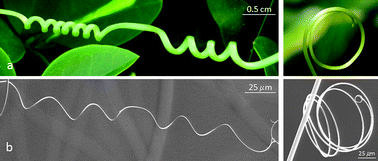Self-winding of helices in plant tendrils and cellulose liquid crystal fibers†
Abstract
Passiflora edulis, like other climbing plants, possesses long, tender, soft, curly and flexible organs called tendrils whose

* Corresponding authors
a Departamento de Ciência dos Materiais and CENIMAT/I3N, Universidade Nova de Lisboa, Caparica, Caparica, Portugal
b Cavendish Laboratory, University of Cambridge, J.J. Thomson Avenue, Cambridge, U.K.
Passiflora edulis, like other climbing plants, possesses long, tender, soft, curly and flexible organs called tendrils whose

 Please wait while we load your content...
Something went wrong. Try again?
Please wait while we load your content...
Something went wrong. Try again?
M. H. Godinho, J. P. Canejo, G. Feio and E. M. Terentjev, Soft Matter, 2010, 6, 5965 DOI: 10.1039/C0SM00427H
To request permission to reproduce material from this article, please go to the Copyright Clearance Center request page.
If you are an author contributing to an RSC publication, you do not need to request permission provided correct acknowledgement is given.
If you are the author of this article, you do not need to request permission to reproduce figures and diagrams provided correct acknowledgement is given. If you want to reproduce the whole article in a third-party publication (excluding your thesis/dissertation for which permission is not required) please go to the Copyright Clearance Center request page.
Read more about how to correctly acknowledge RSC content.
 Fetching data from CrossRef.
Fetching data from CrossRef.
This may take some time to load.
Loading related content
